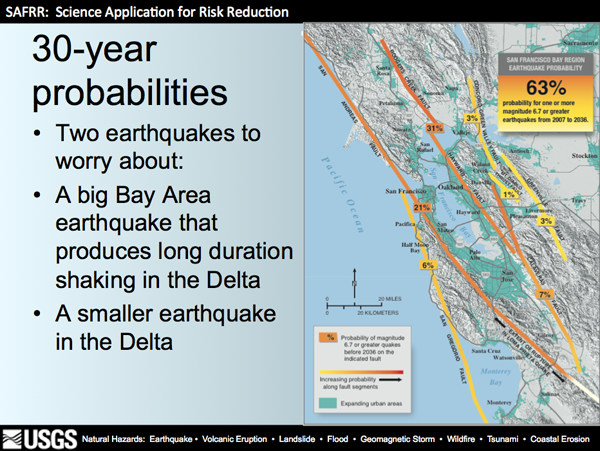TPR is pleased to present part two of “The Delta: Resiliency After an Event,” a panel from this year’s VerdeXchange conference focusing on the Delta’s vulnerability to natural disaster and featuring Jeff Kightlinger, General Manager at the Metropolitan Water District; Gerald Meral, Deputy Secretary of the California Natural Resources Agency; Jack Baylis, Senior Vice President of the Shaw Group; Paul Brown, a International Water Association Fellow; Lucy Jones, Senior Advisor for Risk Reduction at the USGS; and Phil Isenberg, Chair of the Delta Stewardship Council. Part one of this two-part series can be found in TPR’s February 2013 newsletter or online at http://www.planningreport.com/2013/02/19/threat-water-supply-after-event-necessitates-delta-fix

Paul Brown
"Those physical pipes and pumps are relatively robust and can be designed to handle most earthquakes and floods. Their core purpose and real value, however, is entirely linked to the water they store and convey. Consequently, the ecosystem’s fragility has made the water storage and conveyance system increasingly vulnerable and surprisingly fragile itself." -Paul Brown
David Abel: Regarding the resiliency of America’s infrastructure after “an event,” few are as knowledgeable as Paul Brown. Paul has an extensive 40-year experience working for multiple states and jurisdictions. Paul, please speak to the resiliency issue and what’s needed vis a vis California’s Delta.
Paul Brown: Well, I appreciate being asked to be on this VerdeXchange Delta panel because for many years I’ve been a water resources planner. And often I am asked to address infrastructure reliability. But rarely am I asked to address resiliency on the water side of the issue.
In one sense you could look at the current Bay Delta Conservation Plan (BDCP) as a resiliency plan focused on the Delta’s ecosystem, which has not been able to bounce back from the terrestrial and water diversion stresses placed upon it. Think of the Delta today as a system of systems, so in addition to the ecological system demands for resiliency that are the basis of the BDCP (if you really over simplify it), we’ve got the physical water diversion, storage, and transmission facilities that supply water for cities and agriculture as far south as San Diego. Those physical pipes and pumps are relatively robust and can be designed to handle most earthquakes and floods. Their core purpose and real value, however, is entirely linked to the water they store and convey. Consequently, the ecosystem’s fragility has made the water storage and conveyance system increasingly vulnerable and surprisingly fragile itself.
Allow me to address one additional institutional system—the system that is associated with reconciling political, regulatory, and stakeholder interests that control what happens in the Delta (“influence” might be a better word—I’m not sure anyone controls it). As I was thinking about this, I realized that it might actually be one of those systems that represent what Nassim Nicholas Taleb talks about as anti-fragile. (Nassim Nicholas Taleb, the bestselling author of The Black Swan is one of the foremost thinkers of our time on how to thrive in an uncertain world.) He describes anti-fragility as those systems that get stronger in chaos. Looking at what has gone on in the Delta, I would say that the emergency responders—some of whom are sitting right beside me—have gotten stronger, stronger in crafting a plan that is incredibly comprehensive and very thorough in doing the best it can to figure out how to meet the co-equal goals of ecosystem resilience and water supply reliability.
These same responders—and I say this from my professional experience with both Katrina and in New York City—become very effective in getting things done “after an event” occurs.
So you see New Jersey Governor Christie shaking hands with the President of the United States right in the middle of the election, thanking him for his cooperation and support in responding to Hurricane Sandy. California leaders will perform the same way when an equally damaging event happens here. The conclusion I came to a long time ago is, whatever you’re planning to do after an event happens, why don’t you start doing it now, before it happens? It will make the impact a lot easier to deal with then.
Why don’t we feel this urgency?
I’m not going to answer that question—go look at Thinking Fast and Slow. When it comes to our statistical intuition, we don’t have any. We know these events are going to happen, but we truly believe it’s not going to happen today. One day we’re going to be horribly wrong, and we are going to wish we started addressing this issue sooner.
David Abel: Thank you, Paul. Phil Isenberg, you’ve been thinking about this for some time, and we welcome you to pick up on Paul Brown’s observations.
Phil Isenberg: The United States is currently manufacturing another all-purpose, fighter airplane—at the cost of I cannot remember how many millions of dollars per plane—in an attempt to solve all of the problems faced by all the branches of the military at the same time, with one airplane. It should not surprise anyone that that will not work very well. So the lesson is, where you start is where you end. And this is just like every other public policy.
There’s a disaster in the Delta. Whatever causes it, the death and damage to the economy will be the most severe and immediate within the Delta. The response to that is now, in-the-future-and-always-has-been, primarily local agency responses—cities, counties, flood districts, etc. It is worth noting, at the present time, of the five counties that have territory within the Delta, only one has completed a Delta-specific emergency response plan to deal with people and property in their area. The others are waiting for Jerry Meral to give them a ton of money so they can do it.
For the local areas, flood control is protection of themselves, their families, their properties, their industries, their businesses, their agriculture, first and primarily. And it’s understandable that that is their concern.
The second theory, for those who depend on water from the Delta, a potential interruption of water supply from the Delta is the most important thing. Put aside the fact that it’s merely one of the most important things in a larger perspective, but there it is. Jeff mentioned, and he’s correct, that of all the water that you use for human purposes in California, only about 15 percent comes from Delta sources. But it is a very important source. Some areas of the state will be totally unaffected by the interruption of the Delta water supply. North Coast Rivers, the North Coast areas of California, are classic examples. Some of the communities in the Central Valley that have their own pipes into the Sierra Nevada will be largely affected.
The third thing is the water will get saltier, especially if there’s an earthquake or flood-caused disruption to some of the Delta islands. Just the sheer mechanics of it—the salt water moves further up river. That’s not particularly unknown; we have an occasional wandering sea line in Sacramento. To the puzzlement of one and all we occasionally get whales that come up the river causing great consternation and activity.
The saltier the water, the more we are required to treat it. Salty water, which is a water quality problem in many ways, is primarily a money question. You can build treatment plants, but they cost billions of dollars. The notion that you build a gazillion-dollar water treatment plan for salty water in the odds that you’ll use it once every 150 years is a little, to me, like the flood barrier in the Netherlands that has been operated now, at great expense, once, for a test. Catastrophic failures in the Delta will severely impact the current environment. It is not a case anymore where you have immense acres of unused land waiting to be flooded with great periodic benefit to the ecosystem. We have removed 95 percent of the wetlands through the Central Valley of California, and it is very hard to figure out how to make this all work.
Now, the world is not coming to an end. But the management problems are just damn complicated. On flood control, generally, we relied on levees that people started off building themselves in the Delta that are subject to great criticism by professionals because of the poor soil that was used. Then we channelized the water to serve a bunch of purposes. We made the levees really close to the water to direct flow through the channels and wash out all that gold mining and debris from hydraulic mining. But once that happens and the debris is gone, then all of a sudden the levees have to withstand a greater force of water running through them than most of them were designed for. We now respond with all of that plus massive flood bypasses that are the key ingredient, and the Delta is, in many ways, similar to the Mississippi in terms of the pattern and activities—levees combined with bypasses.
The other thing is big cities—Sacramento, Stockton, West Sacramento—are among the most severely flood-threatened in the nation, and all of that goes on because the Delta is inherently flood-prone. There’s nothing we can do to remove the risk. You can minimize the risk, and you can try to adjust for it and accommodate it. In the Netherlands North Sea Flood of 1953, 1836 people were killed. Today the Netherlands has their flood control protection at 10,000-25,000-year levels, and we just moved 200-year levels for some places in California. All of that adds up to a really vicious mix of choices and options. It will be damnably expensive. You want a system that is as protective as is reasonably to be expected, but you have to acknowledge there is always going to be a level of protection you cannot provide.
David Abel: I want to turn back to you, Jeff, not to take that on directly, but to respond to the following notion: is the threat referenced by Paul observably today enough to change the discussion of who pays for what, in your opinion?
Jeff Kightlinger: It hasn’t been to date. To date, the fact that there is a serious threat has received notice, but it’s slow. We have been working on this BDCP for seven years now, and it’s going to be a $250-million plan without any earth turned or levees strengthened. So we love to plan, but we are reluctant to act when there’s going to be controversy. So to date the threat hasn’t been enough to motivate people, but at least it’s gotten things started. It’s going to be up to Jerry Meral to finish things now, but he’s on point, and he’s giving people money, and he’s pushing things forward. I do believe the threat at least has begun the process, though it is a slow process.
- Log in to post comments




